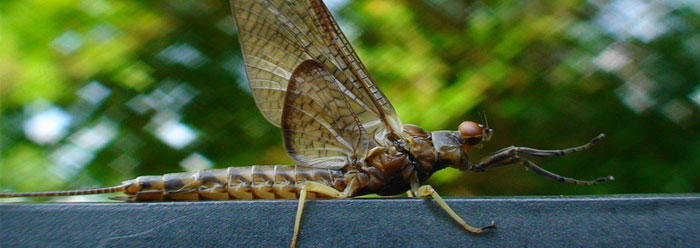Never before had the fossil of a flying insect been discovered in Carboniferous rocks, which are said to be over 300 million years old. But now, amazing impressions have been found in “sandstone with thin mudstone drapes,” according to a technical report in the Proceedings of the National Academy of Sciences.1 This fossil shows that fully developed flight features appeared suddenly in the fossil record, with no trace of gradual evolution.

The report’s authors made an impressive case for this being a mayfly cast and mold (called a “concretion pair”), even though its wings were not evident—only body and leg impressions. The researchers reasoned that the best scenario for fossilization was that the creature landed in wet sandy mud that was deposited as a result of a flood. Then, the water “was able to drain rapidly after flooding.”1
If evolution were true, the complicated suite of features required for flight—including balance sensors, landing strategies, wind speed detectors, and coordinated muscular action, as well as a gradually growing wing size over many generations—must have taken eons to evolve. But this “oldest trace fossil”1 of a flying insect shows no indication of gradual evolution, no transitional or half-developed or “proto” features.
Since many different insects can fly, evolutionists are forced to insist that insect flight evolved half a dozen times. Where are all the fossilized evolutionary experiments that show this? Not one exists.
In 2004, authoritative paleontologist Donald Prothero tacitly acknowledged the lack of evidence from fossils or elsewhere for the evolution of flight. He wrote:
Apparently, insect wings evolved in the Mississippian, but so far there are no insect localities of Devonian or Mississippian age (primarily because of the widespread high sea levels and marine conditions that restricted the number of terrestrial deposits) to document how wings first developed.2
This mayfly was found in rock designated as Pennsylvanian, which is situated just above Mississippian strata in some locations. It is therefore much closer to Mississippian than other fossil flying insects discovered so far, and it still totally fails to “document how wings first developed.”
But what is documented by this and other insect fossils coincides with what is documented in Scripture. The creation model holds that in the beginning, God created certain creatures to fly. Both the written and the fossil records agree that insect flight did not evolve, but suddenly appeared as a fully developed and completely functional ability.
Reference
-
-
Knecht, R. J., M. S. Engel and J. S. Benner. 2011. Late Carboniferous paleoichnology reveals the oldest full-body impression of a flying insect.
-
Proceedings of the National Academy of Sciences.108 (16): 6515-6519. Prothero, D. 2004. Bringing Fossils to Life, 2nd ed. Boston, McGraw-Hill, 283.
-
* Mr. Thomas is Science Writer at the Institute for Creation Research.
Recent Articles from Creation Research and also see VCA’s Creation Articles
-
- Jurassic Spider: What’s in a Name?
- ‘Demon Reptile’ Is Not a Missing Link
- Did Flower Study Catch Evolution in the Act?
- Historic ‘Primordial Soup’ Study Yields New Data, But Not New Answers
- Fruit Fly DNA Not as Well Known as Scientists Thought
- Shark Jaw Opens Questions about Coal Formation
- Duplicated Plant Genes Don’t Solve Darwin’s ‘Abominable Mystery’




